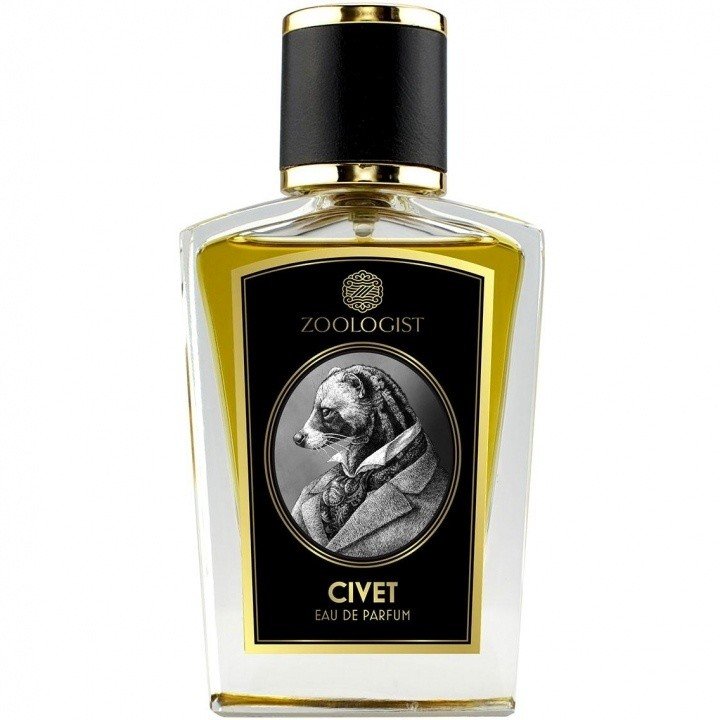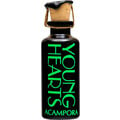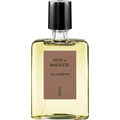56
Top Review
Translated
Show original
Kopi Luwak and an old acquaintance
As soon as a fragrance is named after an - admittedly nowadays synthetically produced - animal scent component, in the case of civet you can actually already be sure of several misunderstandings and the resulting typical reactions ("Eww!", "Uäähh!", "Bäh!"): Namely, that the scent would have something to do with cats and/or cat urine smell. The misunderstanding is partly based on the assumption that civets are real cats. But they are nocturnal mammals, which are found in several subspecies from Southern Europe over Africa to Asia and have very little to do with the cats we know. From a distance and in the dark they may look a bit like cats when creeping around, which is why they are also called "sneak cats".
That civet as a fragrance building block has come under suspicion to smell like cat pee, has its cause possibly in the fact that the substance was formerly obtained from the strongly greasy and malodorous secretion of the anal glands of civets, which has nothing to do with urine, and that, among other things, urinous scents can be perceived in civet-containing perfumes, which is, however, only indirectly related to the civet.
In fact, what is commonly perceived as a urinous odor is not due to the urine itself at all. Fresh urine is relatively odorless, which anyone can determine for themselves by a spirited sniff. Don't be shy! After all, we're among ourselves here and I won't tell anyone. Speaking of which: You know how doctors used to diagnose diabetes mellitus in patients? They would dip their finger in the patient's urine to taste the taste of the urine: sweet equals sugar equals diabetes. Here you go. And now come at me again with "Whoo, the smell here has a horrible pee-pee note, it's making me bloomy!".
How does the typical urine smell in the urine come about then? It is bacterial decomposition products, namely the sharp bitter ammonia, which produce the typical unpleasant pipi smell. Animal scents, and thus also urinous scents (I'm sorry, but one has to call a spade a spade) in perfume can nevertheless - in the right homeopathic dilution - make up the special charm of a scent and give it the necessary touch of sophistication. Without this pinch Untertenrum, neither Kouros, nor Jicky, as a modern representative immediately MAAI comes to mind, possibly ever reached their legendary reputation and quality.
However, these olfactory memories of the fact that we come from the animal world, and with which we apparently in our today's thoroughly disinfected, germ-poor, mask-armed time but somehow difficult to do, are often not to be attributed solely to the used animal ingredients such as civet, musk, amber, Hyraceum, Castoreum and the like. In addition to their own olfactory justification in fragrances, the aforementioned substances also have fixative or other fragrance components with stronger projecting functions. Rather, the odorous "touch of piss" (or other substances, but we don't want to exaggerate today) is also created by the clever combination with floral notes such as carnation, neroli, jasmine and white flowers with their responsible proportions of idol and scatol. Also citrus or herbaceous notes such as sage and lavender can create a urinous fragrance aspect, depending on the context.
I'm sincerely sorry. I didn't mean to ruin your freshly showered floral dreams. And "toilet lemon", you can see how close pee and citrus are sometimes literally together, is here in this forum yes now a fixed part of the Parfumo-speak.
The great Chypres of the past play with their often pronounced animalic notes virtuoso on this keyboard. And "Civet" continues this tradition with a touch of these "old vibes". To understand which story Victor Wong, creative head of Zoologist, together with his perfumer Shelley Waddington tells in Civet, you have to go back to the Indonesian sneaky cat for a moment.
Kopi Luwak is made in Indonesia, among other countries, and is one of the world's most expensive coffees. Originally a literal waste product of colonial coffee cultivation - the laboriously cultivated plantation coffee was reserved exclusively for the colonial powers and their export - the locals resorted to a different method to get their hands on the coveted hot beverage. They collected undigested coffee beans found in the excrement of creeping cats. In the animal's intestines, the coffee cherries are subjected to fermentation by enzymes, which alters the flavor characteristics and gives the coffee an earthy, syrupy, rich aroma with undertones of jungle and chocolate, which I would attest to, unless my memory of the cup of kopi luwak I was once served in Indonesia is deceiving.
"Civet" surprises at one moment with a caramel coffee note when you're not expecting it, but more on that later. Nevertheless, it would not occur to me to call the fragrance a gourmand, for this it lacks the necessary sweetness and the impression of having something edible in front of you. I also lack for the category "animal fragrance" the correspondingly strong aspects.
The fragrance opens with a fair amount of black pepper, a touch of green herbaceousness and citrus notes of tart bergamot, a squeeze of lemon and especially orange.
Close to the heart, things quickly turn unsweetly floral. Garden carnation and a creamy, slightly camphorous old acquaintance framed unkitschy tropically by frangipani and ylang ylang shine in the twilight of the jungle: A gorgeous mellow tuberose with vintage touches.
One suspects slowly, however, that here possibly also nimble predators with claw-armed velvety paws scurry shadow-like under the trees. The scent now develops a slightly brittle, wiry, roughened, slender texture due to the more prominent base ingredients. Labdanum and oakmoss emerge, along with a leathery and slightly resinous, balsamic, warm quality that I would attribute to musk and civet.
Late now it moves into the kin of floriental chypres in my view, but holds one last surprise: The coffee aroma of Kopi Luwak, which together with a touch of vanilla heliotrope has a softening effect and forms a wonderfully attractive unit with civet and tuberose in my view.
The combination of tuberose and coffee with chypre aspects is certainly daring, and could, and now comes for today the last flat joke in this direction, go full in the pants, which is not the case. The fragrance is completely suitable for everyday use and at the same time exceedingly durable, I can still perceive it days later on my jacket collar.
My thanks to Ergoproxy for the sample!
That civet as a fragrance building block has come under suspicion to smell like cat pee, has its cause possibly in the fact that the substance was formerly obtained from the strongly greasy and malodorous secretion of the anal glands of civets, which has nothing to do with urine, and that, among other things, urinous scents can be perceived in civet-containing perfumes, which is, however, only indirectly related to the civet.
In fact, what is commonly perceived as a urinous odor is not due to the urine itself at all. Fresh urine is relatively odorless, which anyone can determine for themselves by a spirited sniff. Don't be shy! After all, we're among ourselves here and I won't tell anyone. Speaking of which: You know how doctors used to diagnose diabetes mellitus in patients? They would dip their finger in the patient's urine to taste the taste of the urine: sweet equals sugar equals diabetes. Here you go. And now come at me again with "Whoo, the smell here has a horrible pee-pee note, it's making me bloomy!".
How does the typical urine smell in the urine come about then? It is bacterial decomposition products, namely the sharp bitter ammonia, which produce the typical unpleasant pipi smell. Animal scents, and thus also urinous scents (I'm sorry, but one has to call a spade a spade) in perfume can nevertheless - in the right homeopathic dilution - make up the special charm of a scent and give it the necessary touch of sophistication. Without this pinch Untertenrum, neither Kouros, nor Jicky, as a modern representative immediately MAAI comes to mind, possibly ever reached their legendary reputation and quality.
However, these olfactory memories of the fact that we come from the animal world, and with which we apparently in our today's thoroughly disinfected, germ-poor, mask-armed time but somehow difficult to do, are often not to be attributed solely to the used animal ingredients such as civet, musk, amber, Hyraceum, Castoreum and the like. In addition to their own olfactory justification in fragrances, the aforementioned substances also have fixative or other fragrance components with stronger projecting functions. Rather, the odorous "touch of piss" (or other substances, but we don't want to exaggerate today) is also created by the clever combination with floral notes such as carnation, neroli, jasmine and white flowers with their responsible proportions of idol and scatol. Also citrus or herbaceous notes such as sage and lavender can create a urinous fragrance aspect, depending on the context.
I'm sincerely sorry. I didn't mean to ruin your freshly showered floral dreams. And "toilet lemon", you can see how close pee and citrus are sometimes literally together, is here in this forum yes now a fixed part of the Parfumo-speak.
The great Chypres of the past play with their often pronounced animalic notes virtuoso on this keyboard. And "Civet" continues this tradition with a touch of these "old vibes". To understand which story Victor Wong, creative head of Zoologist, together with his perfumer Shelley Waddington tells in Civet, you have to go back to the Indonesian sneaky cat for a moment.
Kopi Luwak is made in Indonesia, among other countries, and is one of the world's most expensive coffees. Originally a literal waste product of colonial coffee cultivation - the laboriously cultivated plantation coffee was reserved exclusively for the colonial powers and their export - the locals resorted to a different method to get their hands on the coveted hot beverage. They collected undigested coffee beans found in the excrement of creeping cats. In the animal's intestines, the coffee cherries are subjected to fermentation by enzymes, which alters the flavor characteristics and gives the coffee an earthy, syrupy, rich aroma with undertones of jungle and chocolate, which I would attest to, unless my memory of the cup of kopi luwak I was once served in Indonesia is deceiving.
"Civet" surprises at one moment with a caramel coffee note when you're not expecting it, but more on that later. Nevertheless, it would not occur to me to call the fragrance a gourmand, for this it lacks the necessary sweetness and the impression of having something edible in front of you. I also lack for the category "animal fragrance" the correspondingly strong aspects.
The fragrance opens with a fair amount of black pepper, a touch of green herbaceousness and citrus notes of tart bergamot, a squeeze of lemon and especially orange.
Close to the heart, things quickly turn unsweetly floral. Garden carnation and a creamy, slightly camphorous old acquaintance framed unkitschy tropically by frangipani and ylang ylang shine in the twilight of the jungle: A gorgeous mellow tuberose with vintage touches.
One suspects slowly, however, that here possibly also nimble predators with claw-armed velvety paws scurry shadow-like under the trees. The scent now develops a slightly brittle, wiry, roughened, slender texture due to the more prominent base ingredients. Labdanum and oakmoss emerge, along with a leathery and slightly resinous, balsamic, warm quality that I would attribute to musk and civet.
Late now it moves into the kin of floriental chypres in my view, but holds one last surprise: The coffee aroma of Kopi Luwak, which together with a touch of vanilla heliotrope has a softening effect and forms a wonderfully attractive unit with civet and tuberose in my view.
The combination of tuberose and coffee with chypre aspects is certainly daring, and could, and now comes for today the last flat joke in this direction, go full in the pants, which is not the case. The fragrance is completely suitable for everyday use and at the same time exceedingly durable, I can still perceive it days later on my jacket collar.
My thanks to Ergoproxy for the sample!
23 Comments
Latest Reviews
 Anarlan 4 years ago
Anarlan 4 years ago
Forest Disco
It is initially strange that the somewhat aging, traditional Italian company Bruno Acampora, founded in the mid-1970s, has taken the risk of launching a seven-scented series called "Acampora 54", which evokes the glamorous pre-Aids disco era of the excessive...
Translated




